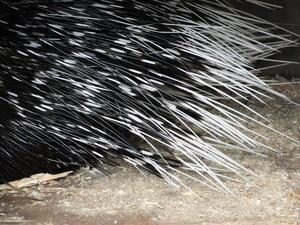Quills
As we pulled into Swift Bird, I saw her. “Allie,” they said her name was. The dog who chased porcupines. And this most recent time, the porcupine had won. Her face and neck were filled with quills, preventing her from opening her mouth or breathing properly. She was so skinny you could see her ribs. It seemed as though she was about to die right in front of us.
I immediately burst into tears. Even as four little girls ran up to the SUV to play with us, I couldn’t feign excitement. It wasn’t as though this was the first striking thing I’d seen in my time on the Cheyenne River Reservation. In fact, a dying dog was much less tragic than the human poverty and desperation I’d encountered. I’d seen houses and community centers covered in graffiti. Just the day before I’d been told a story by a community elder about the recent suicide of his granddaughter. But this dog rattled me. And I wasn’t quite sure why.
Her owners, two girls around the ages of 5 and 7, would run from her when she came near. As I sat down on the pavement and made string bracelets with them, I tried to distract them. To discuss anything other than their dog, dying right before their eyes. But her struggle didn’t seem to faze them. While they would run away when Allie approached them, it seemed that it was the quills, sharp and menacing, that they feared, not death. Their familiarity with tragedy struck me almost as much as the appearance of their dog.
Reflecting on the experience later that night, the words of photojournalist Aaron Huey rang in my ears. I couldn’t understand why it was this incident that spurred me to tears—why it was the struggle of a dog rather than the countless struggles of humans that had made me cry.
I realized that while the image of the dog was extremely graphic, it was what she represented that made me so upset.
“The last chapter in any successful genocide is the one in which the oppressor can remove their hands and say, ‘My God, what are these people doing to themselves?’” Huey says in his TEDTalk.
This dog represented a people so clearly suffering, with a very clear cause, but no clear solution. We all knew what had happened. We knew that a porcupine had quilled Allie. But none of us knew how to help, how to remove the quills without causing further damage. And even more, Allie, like the Lakota people, was blamed for her situation.
Allie’s home, the Cheyenne River Reservation, is also home to four Lakota Sioux tribes. Created by the Fort Laramie Treaty in 1868, the reservation’s origins are rooted in oppression.
The U.S. government “quilled” the Lakota Sioux by forcing them onto a reservation in South Dakota. After the Indian Wars of the 1870s, the government confined them onto a smaller reservation, essentially a prisoner of war camp—another symbolic quill stuck in the body of the Lakota nation. Upon the signing of the Dawes Act of 1887, the U.S. government took back an additional 50% of the reduced allotment. These quills remain today—50% of the land of the Cheyenne River Reservation today belongs to non-Natives, despite them constituting only 10% of the population.
A different bundle of quills, in the form of Native American boarding schools, which deprived generations of Lakota people of their own humanity and culture, began in the late 1800s. Lasting until the 1970s, these schools ripped children from their families and tried to erase the Lakota culture, with the goal of full assimilation into white America. The passing down of Lakota traditions and practices was temporarily stunted. It wasn’t until 1990, with the passage of the Native American Languages Act, that the right for Native Americans to speak their own language was protected by law.
These quills, from the stealing of Native land to the erasure of Native culture, stuck deep into the Lakota Sioux community, have left lasting scars to this day. The legacy of the systematic oppression of these people remains ever-present in the reservation’s poverty, alcoholism, and suicide rates.
Ziebach County, one of the two counties on the reservation, is the 6th poorest county in the U.S. by median household income. Due to the lack of available jobs and educational opportunities, the majority of the population survives on less than one-third of the average American income. And Indian Country Today reported that one in five girls on the reservation has contemplated suicide, and more than one in ten girls has attempted to take her own life.
Many are quick to blame these problems on the inhabitants of the reservation themselves. They blame alcoholism on a lack of self-restraint and irresponsibility. What they do not see is a reservation that is dry by tribal law but has had an influx of bars established and managed by white people. They do not see a community plagued by generational trauma trying their best to survive.
Porcupine quills slide in easily but are very difficult to remove. They are barbed so that upon removal, more harm is inflicted. As Malcolm X once said, “If you stick a knife in my back nine inches and pull it out six inches, there's no progress. If you pull it all the way out that's not progress.”
Similarly, the removal of the quills—from both Allie and the Lakota people—does not solve the problem. Even after the quills are removed, their damage is still felt. The enduring wounds make it difficult for the victims to ever truly disencumber themselves from the harm done.
Allie died before we left the reservation. The attempts of Kat, the white woman who brought us to Swift Bird, to remove the porcupine quills from Allie’s face caused more harm than good. Similarly, the solution is not for white people to intercede in the reservation’s problems; white people have already intervened enough.
After all, in the words of Audre Lorde, “the master’s tools will never dismantle the master’s house.” White people, who for centuries have antagonized the Lakota Sioux, sticking quills into them at every turn, have attempted to become their masters. White intervention is what led to boarding schools, to the destruction of the Lakota language, to the massive reduction in Lakota land. Our tools cannot dismantle the harm we have done. Instead, we must prevent further quills from reaching Native Americans.
My immediate reaction of distress upon seeing Allie has translated into a call to action within me. I cannot stand idly by while Native Americans have their voting rights stripped away. While their land is being taken away for the construction of oil pipelines. Instead of futilely attempting to pull out quills, we must take a stand in the face of these ongoing oppressive measures. We have a duty to show up in solidarity at protests, petition our congresspeople, and boycott problematic organizations. Once quills are inserted, they dig in, and become harder and harder to remove. We have no choice but to prevent their insertion in the first place.
This piece was written as part of JWA’s Rising Voices Fellowship.







